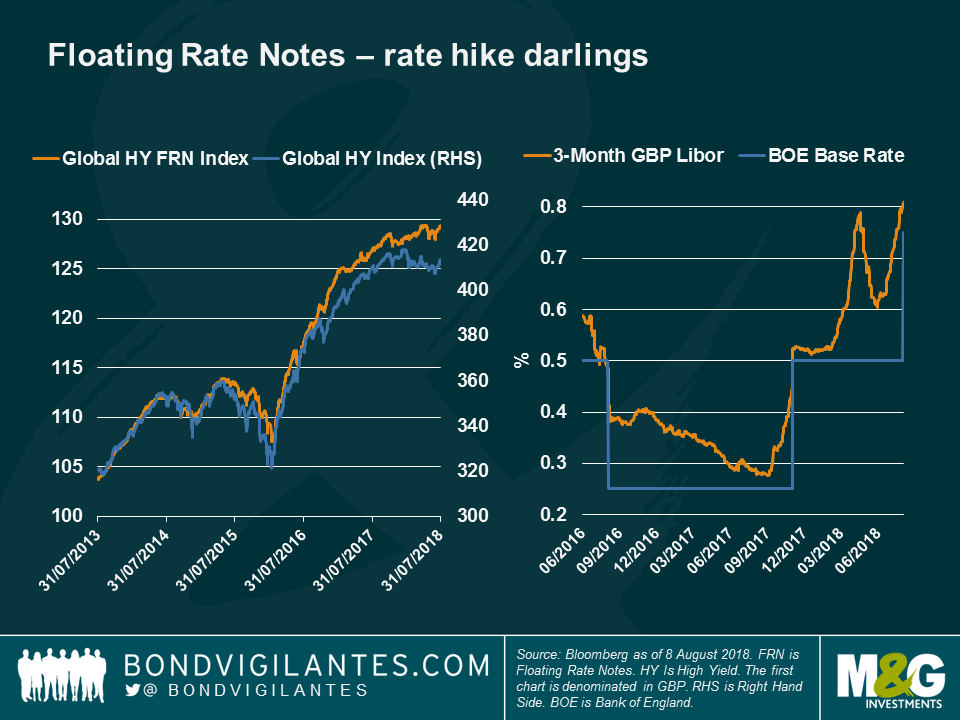Panoramic Weekly: The US vs. the world
Prices of most global corporate bonds rose over the past five trading days, as above-expectations US economic data fuelled the dollar, took US equities to new heights, and the International Monetary Fund (IMF) confirmed its US growth prospects while cutting those for the Eurozone, Britain and Japan. The risk-on optimism left behind Emerging Markets (EM) sovereign debt, hit by the protracted US-China trade tensions, which continued to drag the renminbi down. Global commodities and currencies of the countries that export them, especially to China, suffered.
The strong US Retail Sales and Industrial Production data lifted market-implied chances of a September rate hike to a record high of 92%, pushing short-term yields higher – and the difference between 2 and 10-year US government yields to barely 24 basis points, the lowest since August 2007. Despite reiterated comments about the protracted flattening of the US yield curve, market observers including former US Federal Reserve chair Ben Bernanke warned that a flattening is not an inversion and that the present shape of the curve may not be signalling a forthcoming recession – the curve might be flat and stay flat. The UK yield curve also flattened, albeit depicting a different picture: a lower-than-expected June inflation print pushed long-term gilt yields lower, dragging down market-implied chances of an August rate hike to 83%, down from 91% earlier this week. Oil slumped to US$67 a barrel, down from $74 last week, following a surprise increase in US inventories.
Heading up:
Bunds and inflation – parting ways: German government bond yields continued to diverge from European inflation levels, raising concerns about how realistically Europe’s benchmark yield reflects future interest rate levels. While Eurozone inflation rose to an annualised rate of 2% – the European Central Bank’s (ECB) target level and the highest print in more than a year – German bund yields continued to linger into negative levels, extending the gap between the two, as seen on the chart. Some market observers, such as M&G’s fund manager Wolfgang Bauer, believe the positive European inflation and growth outlook and the ECB’s planned monetary stimulus withdrawal may bring bunds more aligned with inflation prospects again – read Bauer’s “Time to sell Bunds?” to learn more.
CCCs: Carelessly Chasing Coupon? US bonds with the lowest possible rating (CCC) gained 0.3% over the past 5 trading days, more than any other US corporate bracket, largely boosted by the ongoing global yield hunt: US CCC-rated debt offers an average yield of 8.6%, more than the average Non-Investment Grade yield of 6.4%, or the 4% offered by US Investment-Grade debt. In comparison, German and Japanese 10-year government bonds yield a meagre 0.3% and 0.03%, respectively. A low default rate has also helped buoy the CCC-rated asset class: the Moody’s US trailing 12-month speculative grade default rate fell to 3.4% in June, down from 4.0% in March.
Heading down:
Renminbi, copper, peso – war wounds: China’s currency dropped to 6.72 units per US dollar, the lowest level in almost one year, hit by the new import tariffs that the US plans to impose on Chinese products. The trade tensions have become the No. 1 challenge to global growth, which could be reduced by 0.5%, the IMF warned this week. A slowdown in China could hurt leading exporters to the Asian giant, including leading commodity producers (see chart). Copper, an essential component in motors and wiring, plunged 2.9% over the past five trading days, taking its 1-month loss to 12%. Chile, a leading producer of the metal, saw its currency drop 1.6% over the same period, the third-worst EM currency performance against the greenback. Some market observers, however, say that the impact of the trade wars on China might not be as bad as expected as the country shifts its economy to a domestic consumption-led model, from a previous manufacturing and export-led one. China’s economy grew by 6.7% in the second quarter, in line with expectations.
Sterling – a tale of inflation, Westminster plots: The UK’s currency fell by 1.7% against the US dollar over the past five trading days, hit by lower-than-expected inflation in June and by renewed political tensions. Thanks to the support of a small group of rival Labour Members of Parliament, Prime Minister Theresa May narrowly passed her Brexit plan through Parliament earlier this week. In the midst of the political turmoil, London house prices continued to fall: they dropped by 0.4% in May, their fourth consecutive monthly decline.
The value of investments will fluctuate, which will cause prices to fall as well as rise and you may not get back the original amount you invested. Past performance is not a guide to future performance.


18 years of comment
Discover historical blogs from our extensive archive with our Blast from the past feature. View the most popular blogs posted this month - 5, 10 or 15 years ago!


Bond Vigilantes
Get Bond Vigilantes updates straight to your inbox







